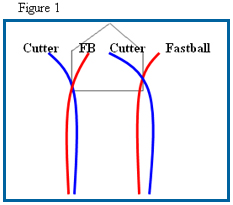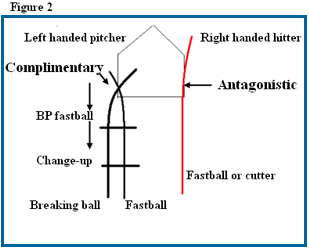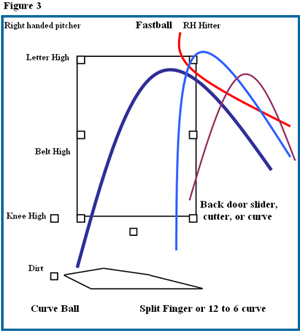PITCHING STRATEGY PART THREE: DEVELOPING YOUR SUCCESS ENGINE – COMPLIMENTARY AND ANTAGONISTIC PITCHES
The cornerstone to successful pitching strategy is the ‘Will to Win’. Every time a pitcher thinks about pitching, picks up a ball to throw, or walks out between the lines, he must have an attitude of preparing to win and of doing all he can to win. Next comes the foundation to successful pitching strategy which is illustrated by the ‘Hedgehog Concept’. A pitcher’s hedgehog concept is made up of the intersecting of three circles:
- Understanding what you believe you are the best in the world at.
- Understanding what drives your success engine or what is essential to your success.
- Understanding what you are deeply passionate about.
- These two aspects were covered in the first two parts of this series.
When a pitcher develops his success engine he simplifies his strategy into its essential parts that make him most effective and give him the best chance for success. He then spends his time on the few critical aspects of his game that make him successful and doesn’t waste his time on the non-essentials.
Typically, when someone thinks of developing a pitching strategy, he thinks in terms of pitching in and out to both sides of the plate, up and down, and changing speeds. Most high school, college, and even pro pitchers throw bullpen after bullpen working on too many pitches at which they are the masters of none. They work on two and four seam fastballs to both sides of the plate, a change-up or split finger, and at least two different breaking balls possibly to both sides of the plate. If this pitcher throws ten pitches each during a workout using all of his pitches to the locations to which he wants to throw, he will throw at least ninety pitches. Pitchers rarely throw half that many pitches in a workout. The reality is that if a pitcher wants to master a pitch or zone he will have to throw a lot more than ten pitches per practice session to both develop and maintain that pitch and its zone.
Greg Maddux is the only pitcher I have seen that has mastered both sides of the plate. His pitching is both simple and extremely difficult at the same time. He mostly throws two pitches, a cut fastball and a moving fastball to both corners of the plate. I call that X’ing both sides of the plate.
 He changes speeds on those two pitches and elevates them once in awhile. He can miss with both of his pitches to either side of the plate when he wants to. He is not overpowering. He just wins fifteen games every year. I have no idea how much work it took Greg to master those two pitches, but if it were easy then there would be a lot more pitchers doing it. Or, maybe he is one of the few who truly understands the essential parts to his success engine. It is extremely difficult to master one side of the plate. Being proficient to both sides of the plate, to me, is what makes Greg one of the all time masters at his craft. Developing his own personal hedgehog concept allows a pitcher to simplify his strategy into only what is essential and effective for him and to not waste time on the non essentials. Understanding your success engine involves understanding what other pitches or aspects must be in your game to compliment what pitch and/or zone you believe you are the best in the world at. There must be a couple of essential aspects to a pitcher’s ‘best in the world pitch’ or zone that must be prevalent in order to effectively develop the rest of his game:
He changes speeds on those two pitches and elevates them once in awhile. He can miss with both of his pitches to either side of the plate when he wants to. He is not overpowering. He just wins fifteen games every year. I have no idea how much work it took Greg to master those two pitches, but if it were easy then there would be a lot more pitchers doing it. Or, maybe he is one of the few who truly understands the essential parts to his success engine. It is extremely difficult to master one side of the plate. Being proficient to both sides of the plate, to me, is what makes Greg one of the all time masters at his craft. Developing his own personal hedgehog concept allows a pitcher to simplify his strategy into only what is essential and effective for him and to not waste time on the non essentials. Understanding your success engine involves understanding what other pitches or aspects must be in your game to compliment what pitch and/or zone you believe you are the best in the world at. There must be a couple of essential aspects to a pitcher’s ‘best in the world pitch’ or zone that must be prevalent in order to effectively develop the rest of his game:
- The location of his best pitch must involve either or both ‘low and away’ and ‘high and tight’. Those two locations are still the toughest for hitters to deal with.
- Pitchers must make the hitter look for pitches in the zone where the pitcher believes he is the best in the world. The only way to do that is to consistently throw strikes and get ahead with your best pitch in your best zone.
- Pitchers must be able to miss off the plate in varying degrees when they want to miss which enables them to expand their zone. If a hitter is anticipating a pitch in a certain zone, he is more apt to swing at pitches just off the plate in that zone. A hitter only has a split second to make up his mind to not swing. When he anticipates and judges that the pitch is in the zone he is looking for, he is more apt to swing at balls just off the plate and out of his hitting area. Mariano Rivera may be the best at this in the Big Leagues, especially to left handed hitters. He pretty much just throws lefties cut fastballs up and in. I continually see these hitters swinging at balls they can not hit way out of the zone.
To understand only the essential pitches that a pitcher needs for success he must think in terms of complimentary and antagonistic pitches. Complimentary pitches are pitches that, for the first few feet out of the pitcher’s hand, travel in the same plane and look just like his best pitch to his best location. Antagonistic pitches are usually thrown to the opposite zone or location of the pitchers best pitch. For example, if a left handed pitcher understands his best pitch in the world is his fastball low and away to a right handed batter then complimentary pitches to his best pitch could be a pitch that is a little off his fastball down and away, a changeup down or down and away, or a breaking ball starting out of his hand at the same location.
 An antagonistic pitch in this situation could be either a fastball or cutter to the inside part of the plate.
An antagonistic pitch in this situation could be either a fastball or cutter to the inside part of the plate.
Another example could be a right handed pitcher whose best pitch is a fastball up and in to right handed hitters. Many of these pitchers, like Roger Clemens, come up and inside off the plate to intimidate hitters. Complimentary pitches for this kind of pitcher are a split finger fastball, a twelve-to-six curve, or a bigger slow curve. In addition, back door curves, sliders or cutters can be effective complimentary pitches for this pitcher. (Fig. 3) Antagonistic pitches for this ‘up and in’ pitcher could be a cutter, slider change-up, or fastball low and away.
I coached a right handed pitcher whose best pitch was a hard breaking ball that he started inside to right handed hitters and broke it low and away on the outside corner. His other pitches were a fastball that he always kept away and an occasional change-up. The hitters soon realized that any pitch that looked inside to them was the breaking ball and his effectiveness suffered. Once he realized that he needed to throw inside fastballs that started out in the same plane as his breaking ball his effectiveness increased.
 These are only a couple of examples to illustrate complimentary and antagonistic pitches. Each pitcher is different. Through practice, repetition, and game situations, he must see which pitches he can throw consistently where he wants to and which pitches are most effective. There may be four or five pitches that could be complimentary for a pitcher, but he should work to understand which one or two he can master that are most effective for him.
These are only a couple of examples to illustrate complimentary and antagonistic pitches. Each pitcher is different. Through practice, repetition, and game situations, he must see which pitches he can throw consistently where he wants to and which pitches are most effective. There may be four or five pitches that could be complimentary for a pitcher, but he should work to understand which one or two he can master that are most effective for him.
One of the best things a pitching coach can do is to have his pitchers throw batting practice. I used to tell my pitchers that it was pitching practice and not batting practice. I would then sit behind a screen behind the mound and instruct them to try new things such as taking a little off the fastball. We would tell the hitter if the pitch was a fastball or a breaking ball but we would not tell him what speed he was throwing. That is the best way I know of, outside of an actual game, to let a pitcher see what effect his pitches may have on a hitter. I got the idea from Gene Mauch when I was pitching for the Angels. One day he had me throw batting practice to three pretty good left-handed hitters as he stood behind me. They were Rod Carew, Fred Lynn, and Reggie Jackson. He told me to tell them I was going to throw low and away. The pitch I threw low and away to lefties was a cut fastball. Gene knew that if I could get the pitch low and away, even these great hitters would hit the ball on the ground in the middle of the diamond. I just needed to see and prove it to myself. I couldn’t tell you how many times I got out of first and third situations with one out by getting a double play ground ball up the middle from left handed hitters. It was because of that one practice episode and me continually working to make sure that pitch was in my repertoire. The hitters knew the low and away cutter was coming but I still got the desired result.
Understanding the few essential complimentary and antagonistic pitches that drive his success engine gives a pitcher a solid plan for winning. It allows him to spend his time developing and maintaining the most important things that make him successful and to not waste his time on pitches that don’t contribute to his game.
By Geoff Zahn
Former Head Baseball Coach University of Michigan and 12 Year Major League Veteran Pitcher
